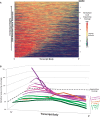Stability, delivery and functions of human sperm RNAs at fertilization
- PMID: 23471003
- PMCID: PMC3627604
- DOI: 10.1093/nar/gkt132
Stability, delivery and functions of human sperm RNAs at fertilization
Abstract
Increasing attention has focused on the significance of RNA in sperm, in light of its contribution to the birth and long-term health of a child, role in sperm function and diagnostic potential. As the composition of sperm RNA is in flux, assigning specific roles to individual RNAs presents a significant challenge. For the first time RNA-seq was used to characterize the population of coding and non-coding transcripts in human sperm. Examining RNA representation as a function of multiple methods of library preparation revealed unique features indicative of very specific and stage-dependent maturation and regulation of sperm RNA, illuminating their various transitional roles. Correlation of sperm transcript abundance with epigenetic marks suggested roles for these elements in the pre- and post-fertilization genome. Several classes of non-coding RNAs including lncRNAs, CARs, pri-miRNAs, novel elements and mRNAs have been identified which, based on factors including relative abundance, integrity in sperm, available knockout data of embryonic effect and presence or absence in the unfertilized human oocyte, are likely to be essential male factors critical to early post-fertilization development. The diverse and unique attributes of sperm transcripts that were revealed provides the first detailed analysis of the biology and anticipated clinical significance of spermatozoal RNAs.
Figures





Similar articles
-
The presence, role and clinical use of spermatozoal RNAs.Hum Reprod Update. 2013 Nov-Dec;19(6):604-24. doi: 10.1093/humupd/dmt031. Epub 2013 Jul 14. Hum Reprod Update. 2013. PMID: 23856356 Free PMC article. Review.
-
A survey of small RNAs in human sperm.Hum Reprod. 2011 Dec;26(12):3401-12. doi: 10.1093/humrep/der329. Epub 2011 Oct 11. Hum Reprod. 2011. PMID: 21989093 Free PMC article.
-
Current status of sperm functional genomics and its diagnostic potential of fertility in bovine (Bos taurus).Syst Biol Reprod Med. 2018 Dec;64(6):484-501. doi: 10.1080/19396368.2018.1444816. Epub 2018 Mar 14. Syst Biol Reprod Med. 2018. PMID: 29537884 Review.
-
The contribution of human sperm proteins to the development and epigenome of the preimplantation embryo.Hum Reprod Update. 2018 Sep 1;24(5):535-555. doi: 10.1093/humupd/dmy017. Hum Reprod Update. 2018. PMID: 29800303 Review.
-
The RNA content of human sperm reflects prior events in spermatogenesis and potential post-fertilization effects.Mol Hum Reprod. 2021 May 29;27(6):gaab035. doi: 10.1093/molehr/gaab035. Mol Hum Reprod. 2021. PMID: 33950245
Cited by
-
Evaluation of the effectiveness of semen storage and sperm purification methods for spermatozoa transcript profiling.Syst Biol Reprod Med. 2013 Oct;59(5):287-95. doi: 10.3109/19396368.2013.817626. Epub 2013 Jul 19. Syst Biol Reprod Med. 2013. PMID: 23869956 Free PMC article.
-
Differences in small noncoding RNAs profile between bull X and Y sperm.PeerJ. 2020 Sep 18;8:e9822. doi: 10.7717/peerj.9822. eCollection 2020. PeerJ. 2020. PMID: 32999759 Free PMC article.
-
Research Progress on the Inflammatory Effects of Long Non-coding RNA in Traumatic Brain Injury.Front Mol Neurosci. 2022 Mar 10;15:835012. doi: 10.3389/fnmol.2022.835012. eCollection 2022. Front Mol Neurosci. 2022. PMID: 35359568 Free PMC article. Review.
-
The effects of di-butyl phthalate exposure from medications on human sperm RNA among men.Sci Rep. 2019 Aug 27;9(1):12397. doi: 10.1038/s41598-019-48441-5. Sci Rep. 2019. PMID: 31455814 Free PMC article.
-
Establishment of a male fertility prediction model with sperm RNA markers in pigs as a translational animal model.J Anim Sci Biotechnol. 2022 Jul 7;13(1):84. doi: 10.1186/s40104-022-00729-9. J Anim Sci Biotechnol. 2022. PMID: 35794675 Free PMC article.
References
-
- Krawetz SA. Paternal contribution: new insights and future challenges. Nat. Rev. 2005;6:633–642. - PubMed
-
- Pessot CA, Brito M, Figueroa J, Concha II, Yanez A, Burzio LO. Presence of RNA in the sperm nucleus. Biochem. Biophys. Res. Commun. 1989;158:272–278. - PubMed
-
- Sutovsky P, Moreno RD, Ramalho-Santos J, Dominko T, Simerly C, Schatten G. Ubiquitin tag for sperm mitochondria. Nature. 1999;402:371–372. - PubMed
-
- Miller D. RNA in the ejaculate spermatozoon: a window into molecular events in spermatogenesis and a record of the unusual requirements of haploid gene expression and post-meiotic equilibration. Mol. Hum. Reprod. 1997;3:669–676. - PubMed
-
- Miller D, Ostermeier GC. Towards a better understanding of RNA carriage by ejaculate spermatozoa. Hum. Reprod. Update. 2006;12:757–767. - PubMed
Publication types
MeSH terms
Substances
Associated data
- Actions
- Actions
- Actions
- Actions
- Actions
- Actions
- Actions
- Actions
- Actions
- Actions
- Actions
Grants and funding
LinkOut - more resources
Full Text Sources
Other Literature Sources
Molecular Biology Databases
Research Materials

